The Role of Digital Marketing in Shaping Sustainable Consumption: Insights from a Systematic Literature Review
Abstract
1. Introduction
2. Materials and Methods
3. Publication Distribution
4. Conceptual Overview and State of the Art
4.1. Digital Marketing and Sustainability
4.2. Strategies Used in Sustainable Digital Marketing
4.2.1. Social Media Advertising
4.2.2. Personalisation
4.2.3. Search Engine Optimisation (SEO)
4.2.4. Social Media Influencers
4.2.5. Intentional and Trendy Product Packaging
4.2.6. User-Generated Marketing
4.2.7. Corporate Social Responsibility (CSR) and Digital Eco-Branding
4.3. Impact of Sustainable Digital Marketing on Consumer Behaviour
4.3.1. Emotional Storytelling Influences Brand Loyalty
4.3.2. Enhanced Customer Satisfaction
4.3.3. Ethical Consumerism
4.3.4. Data-Driven Personalisation and Consumer Trust
4.3.5. Improved Brand Awareness and Relationship with Brands
4.3.6. Improved Decision-Making from eWOM and Brand Reputation
4.3.7. Digital Inclusivity Impacts Buying Behaviours
4.3.8. Positive Brand Perceptions
4.4. How Digital Marketing Impacts Sustainable Purchase Decisions
4.4.1. Green Product Positioning
4.4.2. Fear of Missing out Drives Sustainable Purchasing Decisions
4.4.3. Product Environmental Information Transparency
4.4.4. Influencers and Online Reviews Promoting Sustainable Products
4.4.5. Sustainability-Focused Campaigns
4.4.6. Social Media Exposure and Online Peer Networks
4.4.7. Sustainable E-Commerce and Marketing Strategies
- (a)
- Climate Advocacy
- (b)
- Data Privacy-Conscious Marketing
5. Critical Synthesis
6. Conclusions
Supplementary Materials
Author Contributions
Funding
Institutional Review Board Statement
Informed Consent Statement
Data Availability Statement
Acknowledgments
Conflicts of Interest
Appendix A
| Documents | ≤2015 | 2016 | 2017 | 2018 | 2019 | 2021 | 2021 | 2022 | 2023 | 2024 | 2025 | Total | |
|---|---|---|---|---|---|---|---|---|---|---|---|---|---|
| Adaptation of e-commerce retailing to enhance customer satisfaction within a dynamical system under transfer of risk | 2025 | 0 | 0 | 0 | 0 | 0 | 0 | 0 | 0 | 0 | 0 | 3 | 3 |
| The impact of digital fashion marketing on purchase intention | 2025 | 0 | 0 | 0 | 0 | 0 | 0 | 0 | 0 | 0 | 0 | 2 | 2 |
| Gender Differences in Environmentally Sustainable Consumer Behaviour in the Context of Electronic Commerce | 2025 | 0 | 0 | 0 | 0 | 0 | 0 | 0 | 0 | 0 | 0 | 1 | 1 |
| Guardians of the Green: Exploring Climate Advocacy, Data Privacy-Conscious Marketing, and Social Moral Licensing in Regenerative Tourism in Hawaii | 2024 | 0 | 0 | 0 | 0 | 0 | 0 | 0 | 0 | 0 | 0 | 1 | 1 |
| Digital marketing in community-based enterprises: A systematic literature review and research agenda | 2024 | 0 | 0 | 0 | 0 | 0 | 0 | 0 | 0 | 0 | 2 | 1 | 3 |
| Three decades of research on wine marketing | 2024 | 0 | 0 | 0 | 0 | 0 | 0 | 0 | 0 | 0 | 1 | 5 | 6 |
| Understanding online purchase intention of plant-based foods: Exploring causal factors and moderating role of self-efficacy within the SOR theory | 2024 | 0 | 0 | 0 | 0 | 0 | 0 | 0 | 0 | 0 | 2 | 5 | 7 |
| Learning from the Past Bridging Digital and Physical Markets: A Guidelines for Future Research Agenda of Online-to-Offline (O2O) Marketing Strategy | 2024 | 0 | 0 | 0 | 0 | 0 | 0 | 0 | 0 | 0 | 0 | 1 | 1 |
| Digital Marketing Dynamics: Investigating Influential Factors in Consumer Purchase Behaviour | 2024 | 0 | 0 | 0 | 0 | 0 | 0 | 0 | 0 | 0 | 1 | 1 | 2 |
| Marketing innovation strategies and consumer behavior | 2024 | 0 | 0 | 0 | 0 | 0 | 0 | 0 | 0 | 0 | 1 | 2 | 3 |
| The role of social media in consumers’ intentions to buy green food: evidence from Türkiye | 2024 | 0 | 0 | 0 | 0 | 0 | 0 | 0 | 0 | 2 | 18 | 8 | 28 |
| Research on the Effectiveness of Virtual Endorsers: A Study Based on the Match-Up Hypothesis and Source Credibility Model | 2024 | 0 | 0 | 0 | 0 | 0 | 0 | 0 | 0 | 0 | 1 | 3 | 4 |
| Digital Inclusivity: Advancing Accessible Tourism via Sustainable E-Commerce and Marketing Strategies | 2024 | 0 | 0 | 0 | 0 | 0 | 0 | 0 | 0 | 0 | 3 | 0 | 3 |
| Tourism planning and destination marketing | 2024 | 0 | 0 | 0 | 1 | 0 | 0 | 1 | 2 | 2 | 5 | 1 | 12 |
| Decoding Digital Consumer Behavior: Bridging Theory and Practice | 2024 | 0 | 0 | 0 | 0 | 0 | 0 | 0 | 0 | 0 | 1 | 1 | 2 |
| Managing Social Responsibility for Health: Challenges in Using Digital Marketing for the Promotion of Paid Services of Healthcare Institutions | 2024 | 0 | 0 | 0 | 0 | 0 | 0 | 0 | 0 | 0 | 0 | 1 | 1 |
| Evaluating the Effectiveness of AI-Integrated Digital Marketing on Consumer Behavior, Brand Perception, and Sales Performance | 2024 | 0 | 0 | 0 | 0 | 0 | 0 | 0 | 0 | 0 | 1 | 1 | 2 |
| The Impact of User-Generated Marketing on Creating Greater Audience Connections and Brand Loyalty | 2024 | 0 | 0 | 0 | 0 | 0 | 0 | 0 | 0 | 0 | 2 | 1 | 3 |
| Marketing research trends using technology acceptance model (TAM): a comprehensive review of researches (2002–2022) | 2024 | 0 | 0 | 0 | 0 | 0 | 0 | 0 | 0 | 0 | 18 | 9 | 27 |
| Exploring how IP marketing (media marketing) influences consumer shopping psychology through quantitative and empirical analysis | 2024 | 0 | 0 | 0 | 0 | 0 | 0 | 0 | 0 | 0 | 0 | 2 | 2 |
| Bouncing Back from the Pandemic: Assessing the Implications of COVID-19 on Luxury Brands | 2024 | 0 | 0 | 0 | 0 | 0 | 0 | 0 | 0 | 0 | 2 | 0 | 2 |
| Social Responsibility in Digital Context and Consumer Behavior: The Case of Kuwait | 2024 | 0 | 0 | 0 | 0 | 0 | 0 | 0 | 0 | 0 | 1 | 0 | 1 |
| Persuading Reluctant Customers: The Online Marketing Communications of Car Sharing Firms | 2023 | 0 | 0 | 0 | 0 | 0 | 0 | 0 | 0 | 0 | 0 | 1 | 1 |
| Exploring the role of decision support systems in promoting healthier and more sustainable online food shopping: A card sorting study | 2023 | 0 | 0 | 0 | 0 | 0 | 0 | 0 | 0 | 0 | 3 | 5 | 8 |
| Dominant factors influencing consumer satisfaction with the online purchase decision process through social commerce: A study of organic black rice in Indonesia | 2023 | 0 | 0 | 0 | 0 | 0 | 0 | 0 | 0 | 0 | 2 | 0 | 2 |
| A study on the influence of product environmental information transparency on online consumers’ purchasing behavior of green agricultural products | 2023 | 0 | 0 | 0 | 0 | 0 | 0 | 0 | 0 | 3 | 6 | 3 | 12 |
| Perception of Corporate Reputation in the Era of Digitization: Case Study of Online Shopping Behavior on Young Consumers | 2022 | 0 | 0 | 0 | 0 | 0 | 0 | 0 | 0 | 1 | 2 | 0 | 3 |
| Electric vehicles (EV) and sustainability: Consumer response to twin transition, the role of e-businesses and digital marketing | 2022 | 0 | 0 | 0 | 0 | 0 | 0 | 0 | 0 | 12 | 20 | 7 | 39 |
| Understanding digital consumer: A review, synthesis, and future research agenda | 2022 | 0 | 0 | 0 | 0 | 0 | 0 | 0 | 2 | 12 | 26 | 9 | 49 |
| Examining University Students´ Behaviors Towards Online Shopping: and empirical investigation in an emerging market | 2022 | 0 | 0 | 0 | 0 | 0 | 0 | 0 | 0 | 4 | 4 | 0 | 8 |
| Implementing experiential marketing in the digital age for a more sustainable customer relationship | 2021 | 0 | 0 | 0 | 0 | 0 | 0 | 4 | 3 | 4 | 8 | 4 | 23 |
| Research challenges in digital marketing: Sustainability | 2019 | 0 | 0 | 0 | 1 | 2 | 4 | 10 | 16 | 13 | 15 | 4 | 65 |
| Green products: digital marketing and consumer behavior for sustainability | 2018 | 0 | 0 | 0 | 0 | 0 | 0 | 0 | 1 | 1 | 0 | 0 | 2 |
| Selected possibilities of using online marketing and online advertising on the Slovak and foreign markets | 2017 | 0 | 0 | 0 | 1 | 0 | 0 | 0 | 0 | 0 | 0 | 0 | 1 |
| Advantages and disadvantages between neuromarketing type research and quantitative marketing research | 2015 | 0 | 2 | 0 | 0 | 0 | 0 | 0 | 0 | 0 | 0 | 0 | 2 |
| Architecting MexGro: introducing online experience for shopping ethnic products | 2013 | 0 | 0 | 0 | 0 | 0 | 0 | 0 | 0 | 1 | 0 | 0 | 1 |
| Understanding consumer purchase intention towards biodegradable footwear: A study | 2013 | 0 | 0 | 0 | 0 | 1 | 0 | 0 | 0 | 1 | 0 | 0 | 3 |
| Total | 0 | 2 | 0 | 3 | 3 | 4 | 15 | 24 | 56 | 145 | 82 | 335 |
References
- Yao, L. How Does Sustainable Digital Marketing Affect Consumer Behavior? Am. J. Ind. Bus. Manag. 2024, 14, 261–282. [Google Scholar] [CrossRef]
- Nazish, M.; Khan, M.N.; Khan, Z. Environmental sustainability in the digital age: Unraveling the effect of social media on green purchase intention. Young Consum. 2024, 25, 1015–1035. [Google Scholar] [CrossRef]
- Fazel, H. Digital marketing and sustainability in the era of climate change: PLS-structural equation modeling approach. J. Stat. Appl. Probab. 2024, 13, 491–505. [Google Scholar] [CrossRef]
- Statista Research Department. Retail E-Commerce Sales Worldwide from 2022 to 2028. 2025. Available online: https://www.statista.com/statistics/379046/worldwide-retail-e-commerce-sales/ (accessed on 30 June 2025).
- Prathapkumar, K.S.; KS, S.K.; HN, M.S. Green marketing in the digital age: Exploring sustainable practices and consumer behaviour. Int. J. Exclus. Manag. Res. 2024, 13, 83–89. [Google Scholar]
- Rusidah, S. The role of digital marketing in the Sustainable performance of Indonesian MSMEs: Do the online purchase intention and actual purchase decision matter? Transnatl. Mark. J. 2023, 11, 17–30. [Google Scholar]
- Page, M.J.; McKenzie, J.E.; Bossuyt, P.M.; Boutron, I.; Hoffmann, T.C.; Mulrow, C.D.; Shamseer, L.; Tetzlaff, J.M.; Akl, E.A.; Brennan, S.E.; et al. The PRISMA 2020 statement: An updated guideline for reporting systematic reviews. BMJ 2021, 372, 71. [Google Scholar] [CrossRef] [PubMed]
- Haddaway, N.R.; Page, M.J.; Pritchard, C.C.; McGuinness, L.A. PRISMA 2020: An R package and Shiny app for producing PRISMA 2020-compliant flow diagrams, with interactivity for optimised digital transparency and Open Synthesis. Campbell Syst. Rev. 2022, 18, e1230. [Google Scholar] [CrossRef]
- Rosário, A.T.; Dias, J.C. Exploring the Landscape of Smart Tourism: A Systematic Bibliometric Review of the Literature of the Internet of Things. Adm. Sci. 2024, 14, 22. [Google Scholar] [CrossRef]
- Desai, V. Digital marketing: A review. Int. J. Trend Sci. Res. Dev. 2019, 5, 196–200. [Google Scholar] [CrossRef]
- Petrosyan, A. Number of Internet and Social Media Users Worldwide as of February. 2025. Available online: https://www.statista.com/statistics/617136/digital-population-worldwide/ (accessed on 30 June 2025).
- Kachawangsie, A. Causal factors influencing digital marketing strategy of community enterprise. Int. J. Innov. Res. Sci. Stud. 2025, 8, 610–620. [Google Scholar] [CrossRef]
- Pezzey, J. Sustainability: An interdisciplinary guide. Environ. Values 1992, 1, 321–362. [Google Scholar] [CrossRef]
- Akshintala, S.M. Global e-commerce success: Personalization, SEO, and sustainability in digital marketing. In Digital Transformation and Sustainability of Business; CRC Press: Boca Raton, FL, USA, 2025; pp. 298–302. [Google Scholar] [CrossRef]
- Theofanous, G.; Thrassou, A.; Uzunboylu, N. Digital Inclusivity: Advancing Accessible Tourism via Sustainable E-Commerce and Marketing Strategies. Sustainability 2024, 16, 1680. [Google Scholar] [CrossRef]
- Kuang, Y.; Dong, M. Consumer’s Regulatory Foci and Construal Levels as Determinants of the Effectiveness of Online Marketing Messages: An Abstract; Developments in Marketing Science: Proceedings of the Academy of Marketing Science; Springer: Cham, Switzerland, 2022; pp. 467–468. [Google Scholar] [CrossRef]
- Hidayat, M.; Salam, R.; Hidayat, Y.S.; Sutira, A.; Nugrahanti, T.P. Sustainable Digital Marketing Strategy in the Perspective of Sustainable Development Goals. Komitmen J. Ilm. Manaj. 2022, 3, 100–106. [Google Scholar] [CrossRef]
- Akel, G.; Yilmaz, M.A. Digital Business and Optimizing Operating Strategies; IGI Global: Hershey, PA, USA, 2024. [Google Scholar] [CrossRef]
- Rajagopal, D. Architecting MexGro: Introducing online experience for shopping ethnic products. Emerald Emerg. Mark. Case Stud. 2013, 3, 1–11. [Google Scholar] [CrossRef]
- Arantes, L. Sustainable digital marketing: Proposal for a renewed concept. In Promoting Organizational Performance Through 5G and Agile Marketing; IGI Global: Hershey, PA, USA, 2022; pp. 55–74. [Google Scholar] [CrossRef]
- Remmang, H.; Anzhari, A.; Hasanuddin, A.; Muhammad, M. Transformation in The Development of Small and Medium Micro Enterprises in Utilizing Digital Marketing Technology Competencies in Makassar City, South Sulawesi, Indonesia. J. Logist. Inform. Serv. Sci. 2024, 11, 234–265. [Google Scholar] [CrossRef]
- Sharma, A.K.; Sharma, R. How artificial intelligence is transforming social media marketing: Analysing its potential and addressing concerns. J. Cult. Mark. Strategy 2024, 9, 75–90. [Google Scholar] [CrossRef]
- Arora, S. The Impact of Emotional Storytelling on Brand Loyalty: A Study of Consumer Engagement through Social Media Advertising. J. Inf. Syst. Eng. Manag. 2025, 10, 750–761. [Google Scholar] [CrossRef]
- Armutcu, B.; Ramadani, V.; Zeqiri, J.; Dana, L.-P. The role of social media in consumers’ intentions to buy green food: Evidence from Türkiye. Br. Food J. 2024, 126, 1923–1940. [Google Scholar] [CrossRef]
- Chandra, S.; Verma, S.; Lim, W.M.; Kumar, S.; Donthu, N. Personalization in personalized marketing: Trends and ways forward. Psychol. Mark. 2022, 39, 1529–1562. [Google Scholar] [CrossRef]
- Lim, K.B.; Tan, V.W.J.; Yeo, S.F.; Tan, C.L. Digital Marketing Dynamics: Investigating Influential Factors in Consumer Purchase Behaviour. paperASIA 2024, 40, 59–71. [Google Scholar] [CrossRef]
- De Veirman, M.; Hudders, L.; Nelson, M.R. What is influencer marketing and how does it target children? A review and direction for future research. Front. Psychol. 2019, 10, 2685. [Google Scholar] [CrossRef] [PubMed]
- Azhar, K.A.; Wel, C.A.C.; Hamid, S.N.A. The test of time: A longitudinal study of parasocial relationships with social media influencers. Int. J. Innov. Res. Sci. Stud. 2025, 8, 757–768. [Google Scholar] [CrossRef]
- Castilla-Miguel, L.; Aramendia-Muneta, M.E. Digital marketing tools and market trends in the skincare industry: Consumer behavior and sales growth insights. In Using Influencer Marketing as a Digital Business Strategy; IGI Global: Hershey, PA, USA, 2023; pp. 235–268. [Google Scholar] [CrossRef]
- Cammarelle, A.; Viscecchia, R.; Bimbo, F. Intention to purchase active and intelligent packaging to reduce household food waste: Evidence from Italian Consumers. Sustainability 2021, 13, 4486. [Google Scholar] [CrossRef]
- Doshi, J.; Iyer, K.; Zade, N. Analysis of the Impact of Product Packaging on Buying Decisions of Consumers and Brand Visibility. In Proceedings of the 2023 6th IEEE International Conference on Advances in Science and Technology (ICAST), Mumbai, India, 8–9 December 2023. [Google Scholar]
- Gabelaia, I.; McElroy, J.W. The Impact of User-Generated Marketing on Creating Greater Audience Connections and Brand Loyalty; Lecture Notes in Networks and Systems; Springer: Cham, Switzerland, 2024. [Google Scholar]
- Colicev, A.; Kumar, A.; O’Connor, P. Modeling the relationship between firm and user generated content and the stages of the marketing funnel. Int. J. Res. Mark. 2019, 36, 100–116. [Google Scholar] [CrossRef]
- Wirba, A.V. Corporate social responsibility (CSR): The role of government in promoting CSR. J. Knowl. Econ. 2024, 15, 7428–7454. [Google Scholar] [CrossRef]
- Al-Doseri, F.A.; Aldhmour, F.M.; Al-Jayyousi, O. Social Responsibility in Digital Context and Consumer Behavior: The Case of Kuwait; Springer Proceedings in Complexity; Springer: Cham, Switzerland, 2024. [Google Scholar]
- Kulikova, E.; Kondratenko, I. Eco-branding and consumer behavior: Innovative marketing strategies in ecology and environmental sciences. E3S Web Conf. 2024, 541, 04005. [Google Scholar] [CrossRef]
- Gurtina, P.; Bormane, S. Managing Social Responsibility for Health: Challenges in Using Digital Marketing for the Promotion of Paid Services of Healthcare Institutions; Eurasian Studies in Business and Economics; Springer Science & Business Media B.V.: New York, NY, USA, 2024; Volume 28, pp. 95–108. [Google Scholar] [CrossRef]
- Mai, P.; Day, S.J. Persuading Reluctant Customers: The Online Marketing Communications of Car Sharing Firms. Sustainability 2023, 15, 16651. [Google Scholar] [CrossRef]
- Asheq, A.A.; Tanchi, K.R.; Akhter, S.; Kamruzzaman, M.; Islam, K.M.A. Examining university students’ behaviors towards online shopping: An empirical investigation in an emerging market. Innov. Mark. 2022, 18, 94–103. [Google Scholar] [CrossRef]
- Kang, J.-A.; Hong, S.; Hubbard, G.T. The role of storytelling in advertising: Consumer emotion, narrative engagement level, and word-of-mouth intention. J. Consum. Behav. 2020, 19, 47–56. [Google Scholar] [CrossRef]
- Dave, M.; Makwana, R.; Dua, K.; Srimali, K. Impact of Storytelling and Emotional Branding on Consumer Purchase Behavior in Quick Service Restaurants and FMCG. Int. J. Innov. Sci. Res. Technol. 2025, 10, 1263–1277. [Google Scholar] [CrossRef]
- Datta, A.; Dey, B.K.; Bhuniya, S.; Sangal, I.; Mandal, B.; Sarkar, M.; Guchhait, R.; Sarkar, B.; Ganguly, B. Adaptation of e-commerce retailing to enhance customer satisfaction within a dynamical system under transfer of risk. J. Retail. Consum. Serv. 2025, 84, 104129. [Google Scholar] [CrossRef]
- Kusno, K.; Deliana, Y.; Sulistyowati, L.; Komaladewi, R.; Rochdiani, D.; Trimo, L. Dominant factors influencing consumer satisfaction with the online purchase decision process through social commerce: A study of organic black rice in Indonesia. Int. J. Data Netw. Sci. 2023, 7, 833–846. [Google Scholar] [CrossRef]
- Kumar, P.K.; Anand, B. Understanding consumer purchase intention towards biodegradable footwear: A study. Indian J. Mark. 2013, 43, 16–24. [Google Scholar] [CrossRef]
- Gillani, A.; Kutaula, S. An introduction to special issue: Sustainability and ethical consumerism. Manag. Decis. 2018, 56, 511–514. [Google Scholar] [CrossRef]
- Gadkari, K.; Dhote, T. Factors Affecting Reversal of Plant-Based Meat Consumption: An Empirical Analysis. Indian J. Mark. 2025, 55, 69–85. [Google Scholar] [CrossRef]
- Zhong, Z.Z.; Wang, G. Enhancing Sustainability Marketing Strategies in Online Transactions: A Categorical Factorization Approach. In Proceedings of the 2023 4th International Conference on Computer Science and Management Technology, Xi’an, China, 13–15 October 2023; pp. 752–758. [Google Scholar] [CrossRef]
- Berkey, B. Ethical consumerism, democratic values, and justice. Philos. Public Aff. 2021, 49, 237–274. [Google Scholar] [CrossRef]
- Škerháková, V.; Taha, V.A.; Tirpák, D.; Kráľ, Š. Perception of Corporate Reputation in the Era of Digitization: Case Study of Online Shopping Behavior on Young Consumers. Sustainability 2022, 14, 14302. [Google Scholar] [CrossRef]
- Zaman, U. Guardians of the Green: Exploring Climate Advocacy, Data Privacy-Conscious Marketing, and Social Moral Licensing in Regenerative Tourism in Hawaii. Sustainability 2024, 16, 10297. [Google Scholar] [CrossRef]
- Kharisma, F.; Arifah, I.D.C.; Kautsar, A.; Dewi, R.S. Digital Marketing, Brand Awareness and Customer Relationship Management on Repurchase Intention in E-Commerce Marketplace. In Proceedings of the ICBIR 2024—2024 9th International Conference on Business and Industrial Research, Bangkok, Thailand, 23–24 May 2024. [Google Scholar]
- Yang, S.-H.; Tsai, C.-F.; Leelapattana, W.; Thongma, W. Tourism Marketing Strategies from Price Tags to Brand Value. J. Ecohumanism 2025, 4, 3458–3477. [Google Scholar] [CrossRef]
- Urdea, A.-M.; Constantin, C.P.; Purcaru, I.-M. Implementing experiential marketing in the digital age for a more sustainable customer relationship. Sustainability 2021, 13, 1865. [Google Scholar] [CrossRef]
- Wittenbraker, J.; Wirth, N. Consumer behavior in the marketing information ecosystem. In The Routledge Companion to Consumer Behavior; Taylor and Francis: London, UK, 2017; pp. 509–520. [Google Scholar] [CrossRef]
- Vij, A.; Vij, M.; Farouk, M.; Kumar, P. Evaluating the Effectiveness of AI-Integrated Digital Marketing on Consumer Behavior, Brand Perception, and Sales Performance. In Proceedings of the 2nd International Conference on Cyber Resilience (ICCR), Dubai, United Arab Emirates, 26–28 February 2024. [Google Scholar]
- Swadhi, R.; Gayathri, K.; Dimri, S.; Balakrishnan, A.; Jyothi, P. Role of digital marketing in shaping travel decisions: Consumer behavior in tourism. In Intersections of Niche Tourism and Marketing; IGI Global: Hershey, PA, USA, 2025; pp. 153–175. [Google Scholar] [CrossRef]
- Perez-Aranda, J.; Tolkach, D.; Panchal, J.H. Reputation and eWOM in accommodation decision-making: Insights from Generation Z users. Tour. Rev. 2024. [Google Scholar] [CrossRef]
- Areiqa, A.Y.; Khanfar, I.A.A.; Al-Shaikh, M.S.; Mohammad, S.I.; Vasudevan, A.; Cai-Needs, Z. Digital Marketing Tools and its Impact on Consumer Buying Decisions in Zarqa City, Jordan. J. Posthumanism 2025, 5, 89–100. [Google Scholar] [CrossRef]
- Jansen, L.Z.; Van Loo, E.J.; Bennin, K.E.; van Kleef, E. Exploring the role of decision support systems in promoting healthier and more sustainable online food shopping: A card sorting study. Appetite 2023, 188, 106638. [Google Scholar] [CrossRef]
- Gidigbi, M.O. Digital Technologies for Sustainable Development: Dual Challenge of Sustainability and Inclusivity Perspective. Law Digit. Technol. 2021, 1, 27–36. [Google Scholar] [CrossRef]
- Tran, T.T.S.; Nemeth, N.; Sarker, M.S.I. Digital marketing in community-based enterprises: A systematic literature review and research agenda. J. Open Innov. Technol. Mark. Complex. 2024, 10, 100414. [Google Scholar] [CrossRef]
- Mogaji, E. Transformative transport services: Leveraging sustainability, inclusivity, and technology through marketing management. J. Mark. Manag. 2025, 1–33. [Google Scholar] [CrossRef]
- Stofejova, L.; Gavurova, B.; Kral, S.; Bacik, R.; Fedorko, R. Gender Differences in Environmentally Sustainable Consumer Behaviour in the Context of Electronic Commerce. Montenegrin J. Econ. 2025, 21, 169–178. [Google Scholar] [CrossRef]
- Barbosa, B. Marketing Innovation Strategies and Consumer Behavior; IGI Global: Hershey, PA, USA, 2024. [Google Scholar] [CrossRef]
- Teangsompong, T.; Sawangproh, W. Understanding online purchase intention of plant-based foods: Exploring causal factors and moderating role of self-efficacy within the SOR theory. Heliyon 2024, 10, e30785. [Google Scholar] [CrossRef] [PubMed]
- Tsekouropoulos, G.; Koliouska, C.; Theocharis, D.; Andreopoulou, Z. Green products: Digital marketing and consumer behavior for sustainability. Agric. Econ. Rev. 2018, 19, 12–27. [Google Scholar]
- Silva, D. E-commerce and the evolution of consumer behavior. In Evolving Strategies for Organizational Management and Performance Evaluation; IGI Global: Hershey, PA, USA, 2025; pp. 133–154. [Google Scholar] [CrossRef]
- Widodo, A.; Rubiyanti, N.; Madiawati, P.N. Indonesia’s online shopping sector transformation: Analyzing the effects of online shopping app growth, e-commerce user adoption, Generation Y and Z, and shopping app advertising. Pak. J. Life Soc. Sci. 2024, 22, 5547–5563. [Google Scholar] [CrossRef]
- Richardson, N. Sustainable Marketing Planning, 2nd ed.; Taylor and Francis: London, UK, 2024. [Google Scholar] [CrossRef]
- Fauzan, N.; Jaroenwanit, P. Streamlines of Fear of Missing Out through Young Consumer Thrifting Fashion Future Trends: A Bibliometric and Visualization Analysis. Thammasat Rev. 2024, 27, 52–76. [Google Scholar]
- Singh, S.; Banerjee, S. Examining the effects of fear of missing out on sustainable food consumption: A social identity perspective. Asia Pac. J. Mark. Logist. 2024, 36, 2726–2743. [Google Scholar] [CrossRef]
- Purwanto, P.; Rahayu, S. ‘Sexy yes, obesity no’: The role of vloggers in influencing diet food purchase with self-openness moderation. Cogent Bus. Manag. 2024, 11, 2351095. [Google Scholar] [CrossRef]
- Zhang, H.; Luo, X. Exploring how IP marketing (media marketing) influences consumer shopping psychology through quantitative and empirical analysis. Front. Psychol. 2024, 15, 1292636. [Google Scholar] [CrossRef]
- Fu, S.; Ma, R.; He, G.; Chen, Z.; Liu, H. A study on the influence of product environmental information transparency on online consumers’ purchasing behavior of green agricultural products. Front. Psychol. 2023, 14, 1168214. [Google Scholar] [CrossRef]
- Singh, A.; Selvasundaram, K. Information Systems and Digital Marketing: Driving Sustainable Consumer Behavior. Pak. J. Life Soc. Sci. 2024, 22, 2029–2043. [Google Scholar] [CrossRef]
- Diez-Martin, F.; Blanco-Gonzalez, A.; Prado-Roman, C. Research challenges in digital marketing: Sustainability. Sustainability 2019, 11, 2839. [Google Scholar] [CrossRef]
- Gao, W.; Ding, Z.; Lu, J.; Wan, Y. Low-carbon information quality dimensions and random forest algorithm evaluation model in digital marketing. Sci. Rep. 2024, 14, 22416. [Google Scholar] [CrossRef]
- Imran, M.A.U.; Samiun, M.; Dhar, S.R.; Noor, S.K.; Sozib, H.M. A Predictive Analysis of Tourism Recovery Using Digital Marketing Metrics. In Proceedings of the 2024 International Conference on Intelligent Cybernetics Technology and Applications (ICICyTA), Bali, Indonesia, 17–19 December 2024. [Google Scholar]
- Camilleri, M.A. Tourism Planning and Destination Marketing; Emerald Publishing: Bingley, UK, 2024. [Google Scholar]
- Kong, H.; Fang, H. Research on the Effectiveness of Virtual Endorsers: A Study Based on the Match-Up Hypothesis and Source Credibility Model. Sustainability 2024, 16, 1761. [Google Scholar] [CrossRef]
- Gong, S.; Li, C.; Sun, Q. The impact of product line length on online review: Evidence from China‘s automobile market. J. Ind. Eng. Eng. Manag. 2023, 37, 169–182. [Google Scholar] [CrossRef]
- Song, Y.; Zhao, X.; Han, Y. Application of an Online Consumer Review in Real Estate Marketing. In Proceedings of the ICCREM 2015—Environment and the Sustainable Building—2015 International Conference on Construction and Real Estate Management, Lulea, Sweden, 11–12 August 2015. [Google Scholar]
- Almansour, M. Electric vehicles (EV) and sustainability: Consumer response to twin transition, the role of e-businesses and digital marketing. Technol. Soc. 2022, 71, 102135. [Google Scholar] [CrossRef]
- Almashaleh, O.; Wicaksono, H.; Valilai, O.F. A Case Study of Social Media Analytics for Effective Digital Marketing in Textile Circularity. In Proceedings of the 2024 IEEE International Conference on Technology Management, Operations and Decisions (ICTMOD), Sharjah, United Arab Emirates, 4–6 November 2024. [Google Scholar]
- Bačík, R.; Gburová, J. Selected possibilities of using online marketing and online advertising on the Slovak and foreign markets. In Proceedings of the 30th International Business Information Management Association Conference, IBIMA 2017—Vision 2020: Sustainable Economic Development, Innovation Management, and Global Growth, Madrid, Spain, 8–9 November 2017. [Google Scholar]
- Dallabona, A. Luxury Fashion Marketing and Branding: A Strategic Approach; Taylor and Francis: London, UK, 2024. [Google Scholar] [CrossRef]
- Ng, P.M.L.; Chan, J.K.Y.; Lit, K.K.; Cheung, C.T.Y.; Lau, M.M.; Wan, C.; Choy, E.T.K. The impact of social media exposure and online peer networks on green purchase behavior. Comput. Hum. Behav. 2025, 165, 108517. [Google Scholar] [CrossRef]
- Ozturk, E.; Ozturk, L. Impact of COVID-19 on Marketing Communications: New Directions in the Promotional Mix; Studies in Systems, Decision and Control; Springer Science and Business Media: Cham, Switzerland; Kia Motors Deutschland GmbH: Berlin, Germany, 2024; Volume 576, pp. 159–185. [Google Scholar] [CrossRef]
- Güngör, A.S.; Çadırcı, T.O. Understanding digital consumer: A review, synthesis, and future research agenda. Int. J. Consum. Stud. 2022, 46, 1829–1858. [Google Scholar] [CrossRef]
- Thangam, D.; Chavadi, C. Impact of digital marketing practices on energy consumption, climate change, and sustainability. Clim. Energy 2023, 39, 11–19. [Google Scholar] [CrossRef]
- Tanveer, Z. Leveraging Digital Media for Climate Awareness: The Role of Social Platforms in Environmental Advocacy. J. Law Future Secur. 2024, 1, 1–9. [Google Scholar]
- Hemker, S.; Herrando, C.; Constantinides, E. The transformation of data marketing: How an ethical lens on consumer data collection shapes the future of marketing. Sustainability 2021, 13, 11208. [Google Scholar] [CrossRef]
- Mandal, P.C. Capturing marketing information and marketing intelligence: Ethical issues and concerns. Int. J. Bus. Forecast. Mark. Intell. 2018, 4, 99–110. [Google Scholar] [CrossRef]
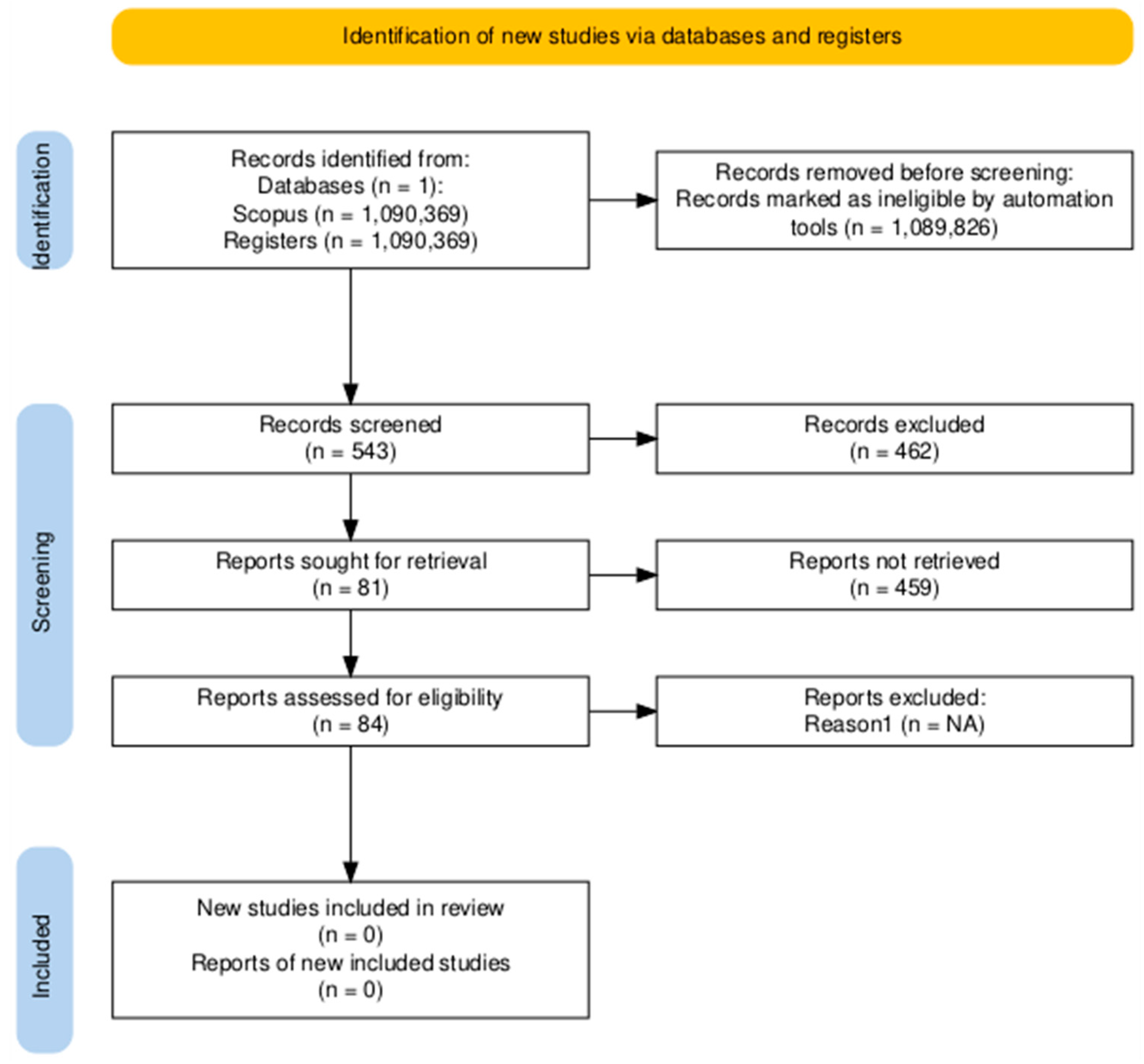
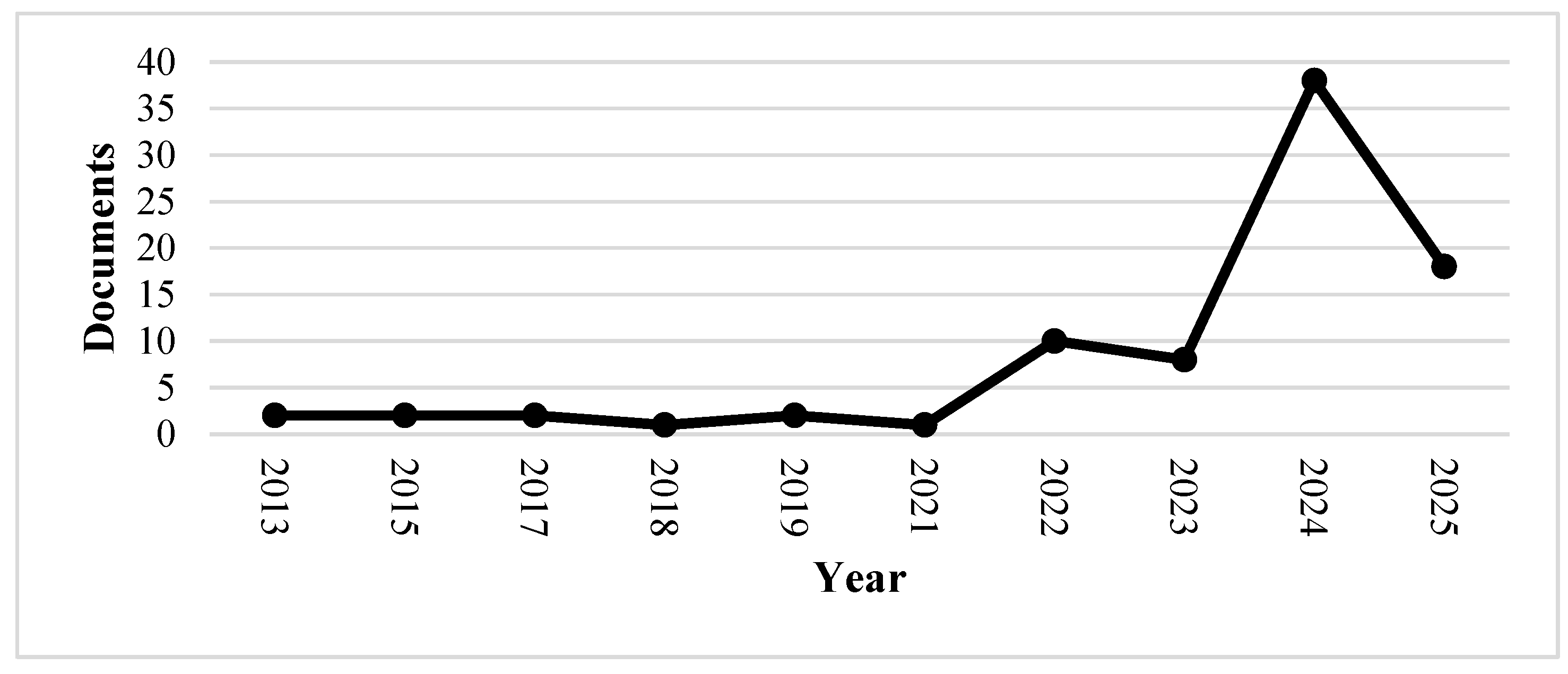
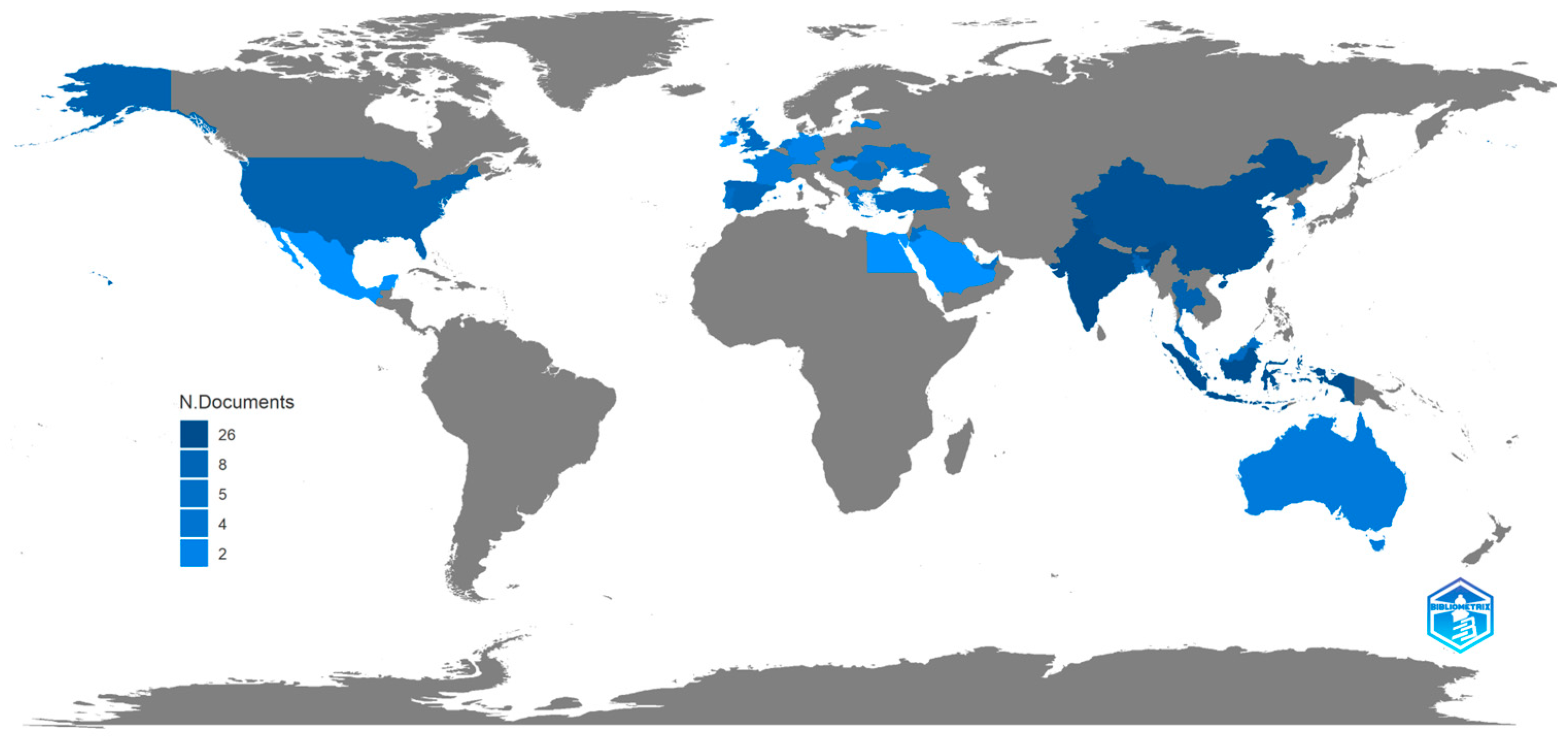
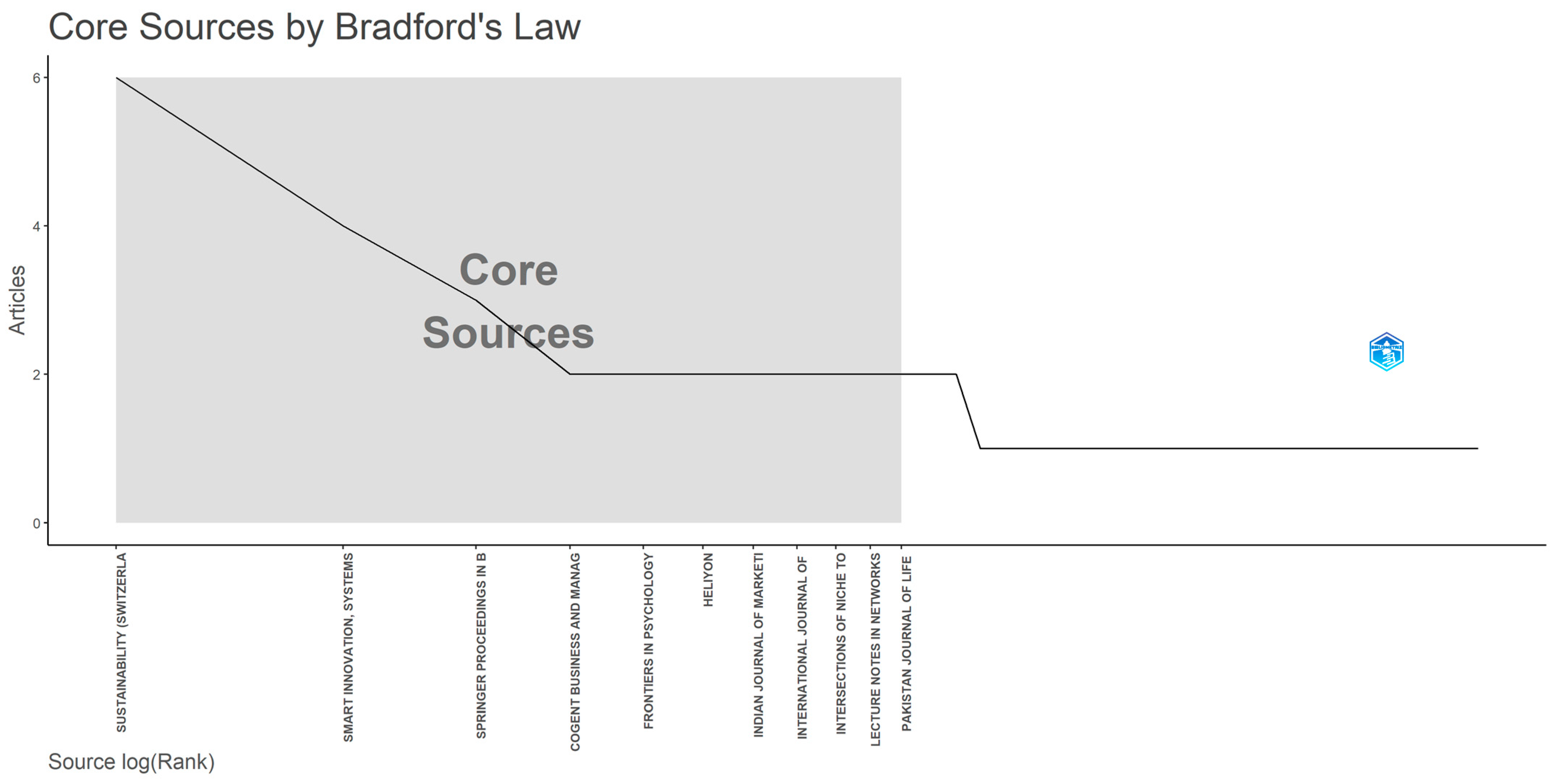
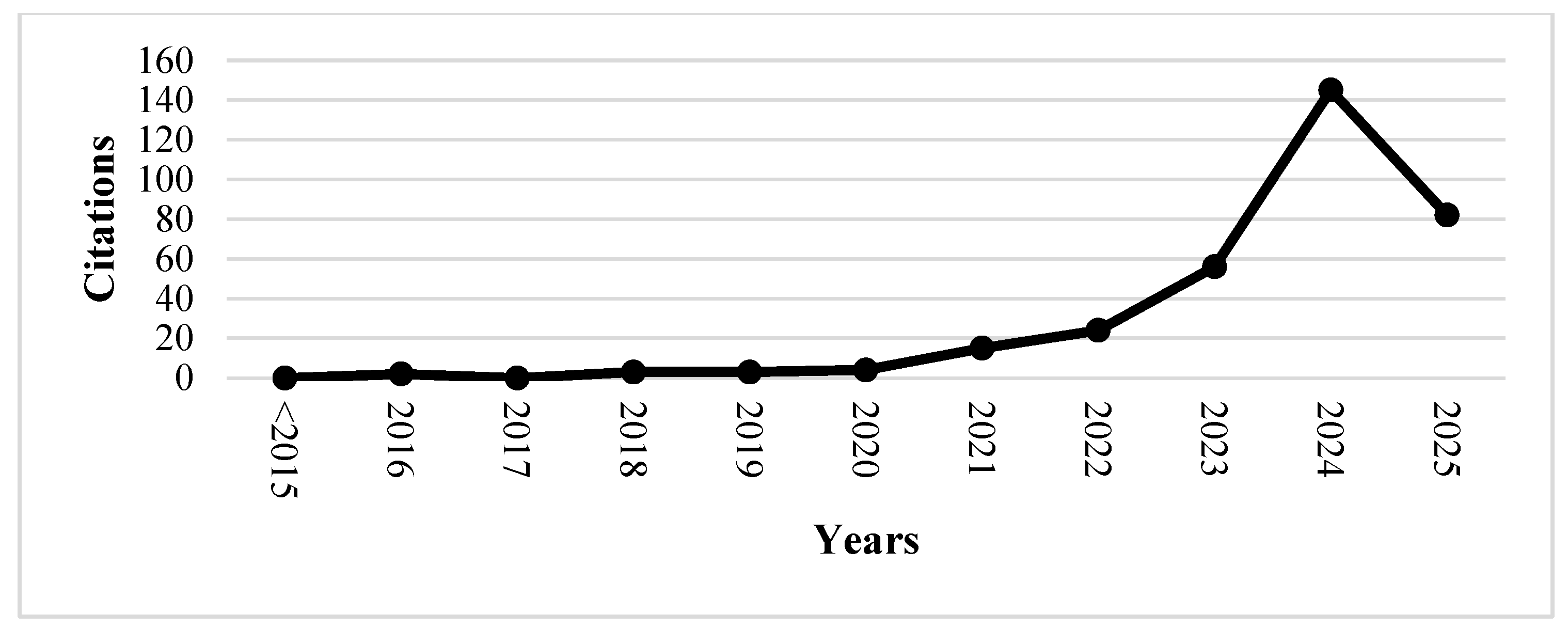
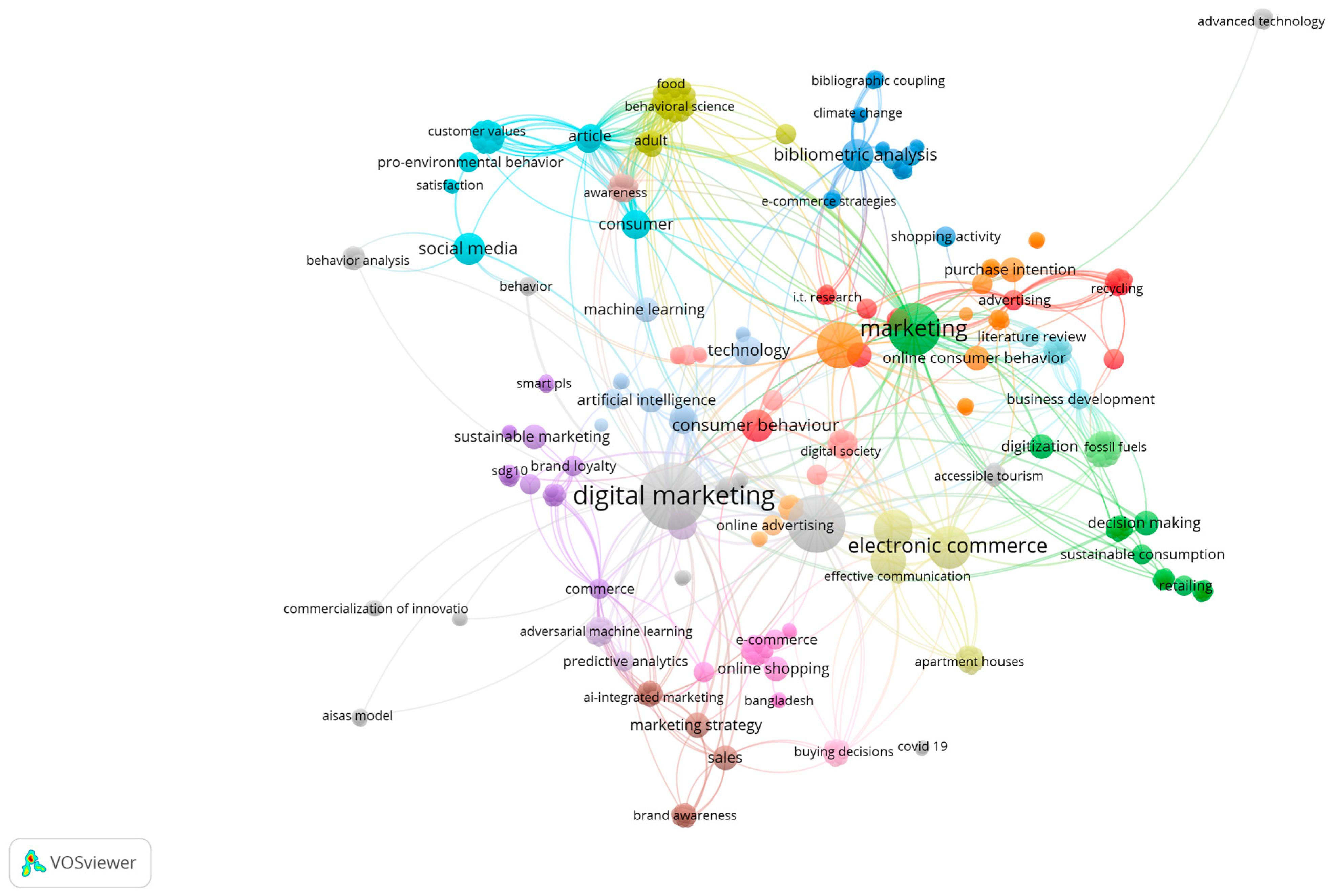
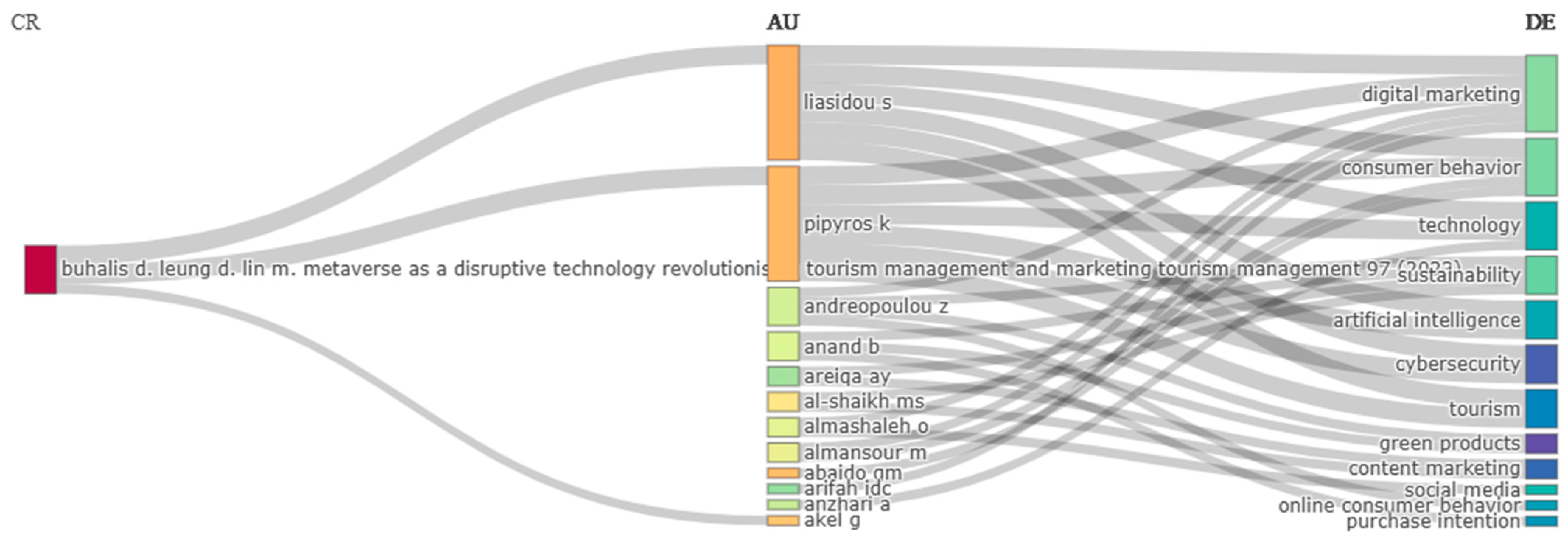
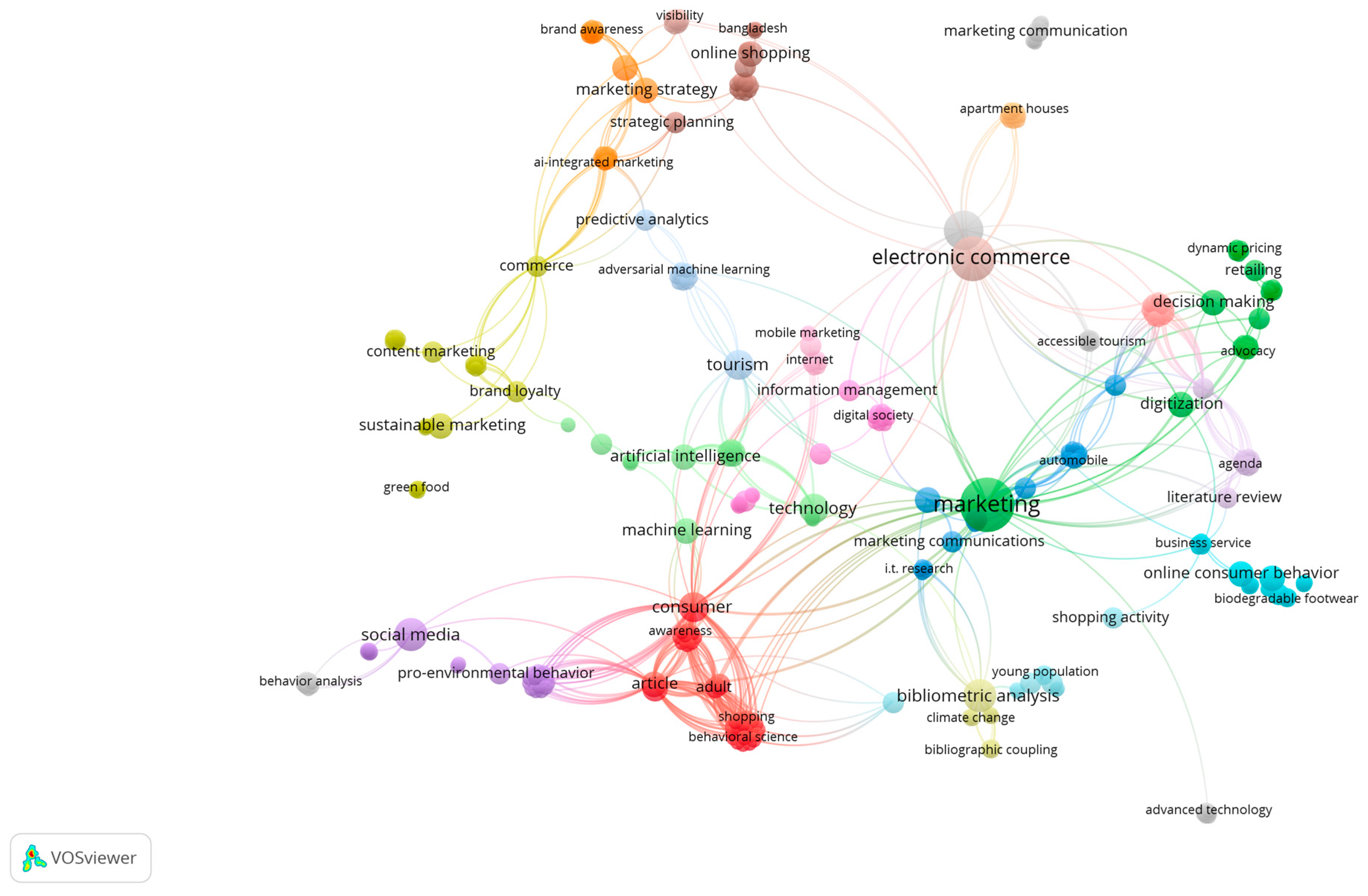
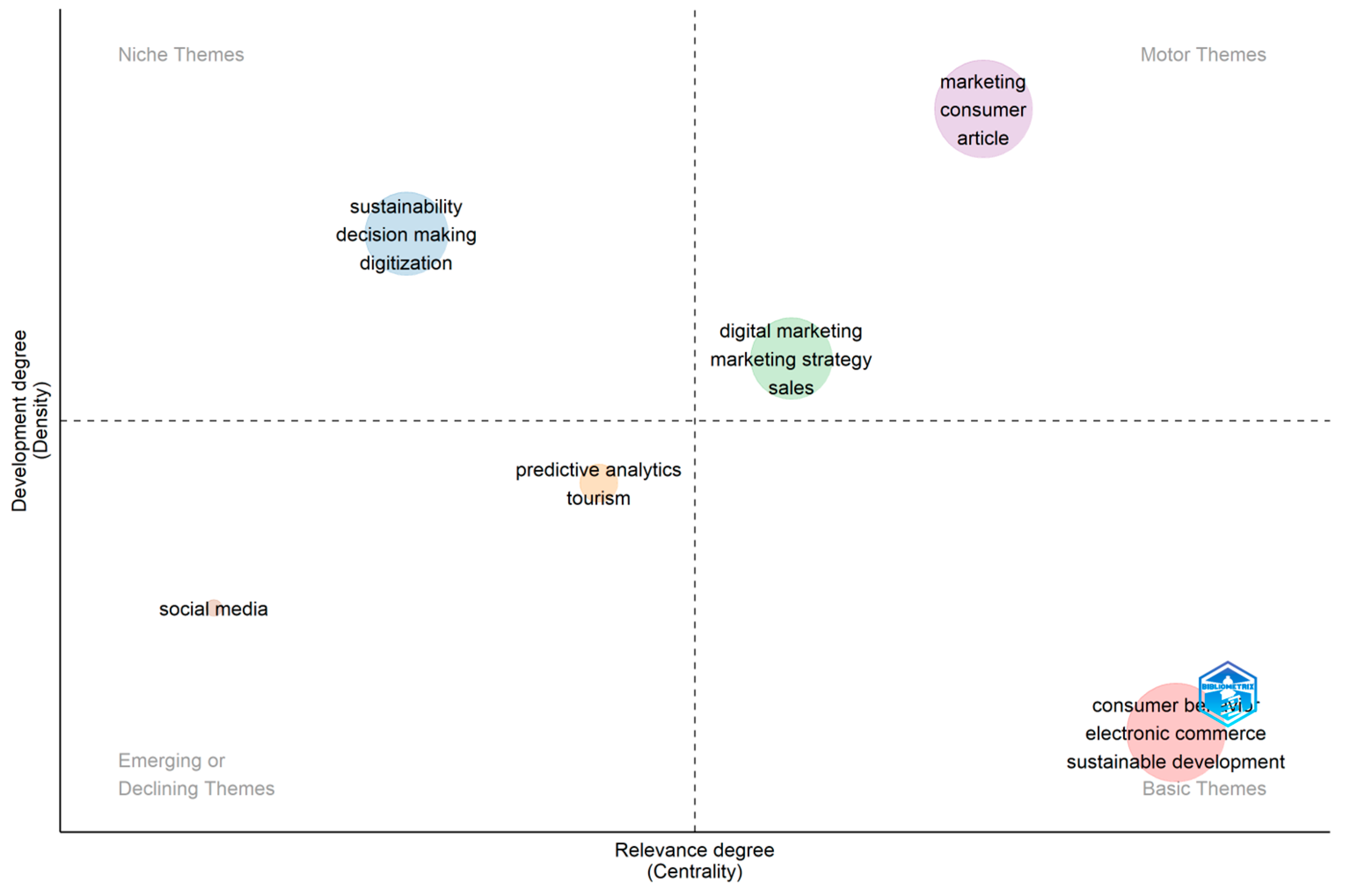

| Phase | Step | Description |
|---|---|---|
| Exploration | 1 | Formulate the research problem |
| 2 | Search for relevant literature | |
| 3 | Critically appraise selected studies | |
| 4 | Synthesise data | |
| Interpretation | 5 | Reporting findings and recommendations |
| Communication | 6 | Present the LRSB report |
| Stage | Search Criteria (Keywords) | Number of Results |
|---|---|---|
| Meta-Search | “sustainable” | 1,090,369 |
| First Inclusion Criterion | “sustainable”; “sustainability” | 1,334,843 |
| Inclusion Criteria | +“digital marketing” | 542 |
| +“online marketing” | 661 | |
| +“consumer behaviour” | 76 | |
| +“consumer attitudes” | 81 | |
| +“purchase behaviour” | 84 | |
| Screening |
| Country | Number of Publications |
|---|---|
| India | 26 |
| Indonesia | 24 |
| China | 21 |
| Slovakia | 11 |
| Thailand | 10 |
| USA | 10 |
| Bangladesh | 9 |
| Spain | 8 |
| Cyprus | 7 |
| South Korea | 7 |
Disclaimer/Publisher’s Note: The statements, opinions and data contained in all publications are solely those of the individual author(s) and contributor(s) and not of MDPI and/or the editor(s). MDPI and/or the editor(s) disclaim responsibility for any injury to people or property resulting from any ideas, methods, instructions or products referred to in the content. |
© 2025 by the authors. Licensee MDPI, Basel, Switzerland. This article is an open access article distributed under the terms and conditions of the Creative Commons Attribution (CC BY) license (https://creativecommons.org/licenses/by/4.0/).
Share and Cite
Rosário, A.T.; Dias, J.C. The Role of Digital Marketing in Shaping Sustainable Consumption: Insights from a Systematic Literature Review. Sustainability 2025, 17, 7784. https://doi.org/10.3390/su17177784
Rosário AT, Dias JC. The Role of Digital Marketing in Shaping Sustainable Consumption: Insights from a Systematic Literature Review. Sustainability. 2025; 17(17):7784. https://doi.org/10.3390/su17177784
Chicago/Turabian StyleRosário, Albérico Travassos, and Joana Carmo Dias. 2025. "The Role of Digital Marketing in Shaping Sustainable Consumption: Insights from a Systematic Literature Review" Sustainability 17, no. 17: 7784. https://doi.org/10.3390/su17177784
APA StyleRosário, A. T., & Dias, J. C. (2025). The Role of Digital Marketing in Shaping Sustainable Consumption: Insights from a Systematic Literature Review. Sustainability, 17(17), 7784. https://doi.org/10.3390/su17177784







